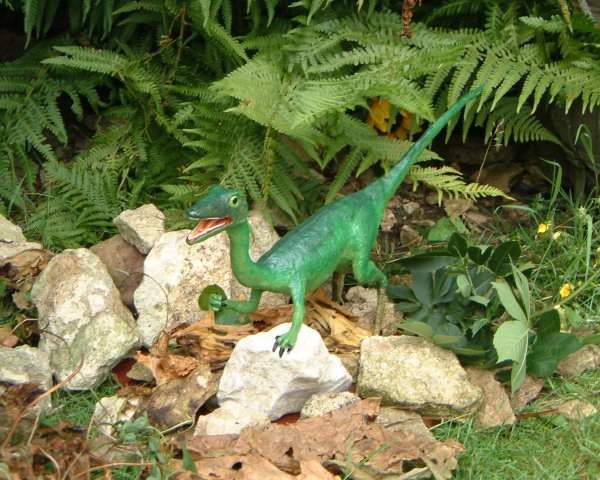- Procompsognathus
Taxobox
name = "Procompsognathus"
fossil_range =Late Triassic

image_caption = Life-sized model of "Procompsognathus triassicus"
image_width = 200px
regnum =Animal ia
phylum = Chordata
classis = Sauropsida
superordo =Dinosaur ia
ordo =Saurischia
subordo =Theropod a
familia =Coelophysidae ?
genus = "Procompsognathus"
genus_authority=Fraas, 1913
subdivision_ranks=Species
subdivision=
*"P. triassicus" Fraas, 1913 (type)"Procompsognathus" (pronEng|ˌproʊkɒmpˈsɒgnəθəs) is a
genus of smalltheropod dinosaur that lived during the LateTriassic Period, about 222 to 219million years ago . "Procompsognathus" was named byEberhard Fraas in 1913. He named thetype species , "P. triassicus", on the basis of a poorly-preserved skeleton found inWürttemberg ,Germany .The name is derived from "
Compsognathus " meaning 'elegant jaw' (Greek "kompsos/κομψος" meaning 'elegant', 'refined' or 'dainty' and "gnathos/γναθος" meaning 'jaw'), which was a later (Jurassic ) dinosaur. The prefix "προ/pro" implies 'before' or 'ancestor of', although this direct lineage is not supported by subsequent research.Paleobiology
"Procompsognathus" may have been about 1.2 meters long (4 ft). A
biped , it had long hind legs, short arms, large clawed hands, a long slender snout with many small teeth, and a stiff tail. It lived in a relatively dry, inland environment and may have eateninsect s,lizard s, and other small prey.Classification
While it is undoubtedly a small, bipedal carnivore, the extremely poor preservation of the only known "Procompsognathus" fossil makes its exact identity difficult to determine. It has historically been considered a theropod dinosaur, though some, such as Allen (2004), have found "Procompsognathus" to be a primitive, non-dinosaurian
ornithodira n. [Allen (2004). "The phylogenetic status of "Procompsognathus" revisited." "Journal of Vertebrate Paleontology", 24(3)] However, Rauhut and Hungerbuhler (2000) noted features of thevertebra e that suggest it may be a coelophysid orceratosaur , and Carrano "et al." (2005), in their re-study of the related genus "Segisaurus ", found both "Segisaurus" and "Procompsognathus" to belong to the Coelophysidae within Dinosauria. [Rauhut and Hungerbuhler (2000). "A review of European Triassic theropods." "Gaia" 15, 75-88.] [Carrano, M.T, Hutchinson, J.R, Sampson, S.D. (2005). "New information on "Segisaurus halli", a small theropod dinosaur from the Early Jurassic of Arizona." "Journal of Vertebrate Paleontology". 25(4):835-849.]In popular culture
In
Michael Crichton 's novels "Jurassic Park " and "The Lost World", "Procompsognathus" (often referred to as "compys") are one of the extinctspecies recreated through genetic engineering. Crichton portrays these dinosaurs as beingvenomous , a characteristic invented for the novel and not supported by fossil evidence. He also portrays them asscavenger s and coprophagists (eaters offeces ), useful in keeping the park clean ofsauropod excrement. In the adaptation of "The Lost World", "Procompsognathus" were replaced with the distantly relatedcoelurosaur "Compsognathus ". However, in the second film, Robert Burke refers to them as "Compsognathus triassicus" ("triassicus" being thetype species of "Procompsognathus").In
Eric Garcia 's trio of "Rex" novels, "Procompsognathus" is one of sixteen genera to survive into the present day. As in "Jurassic Park", Garcia refers to them as "compys".References
External links
* [http://www.dinodata.org/index.php?option=com_content&task=view&id=7169&Itemid=67 "Procompsognathus" at DinoData]
Wikimedia Foundation. 2010.
